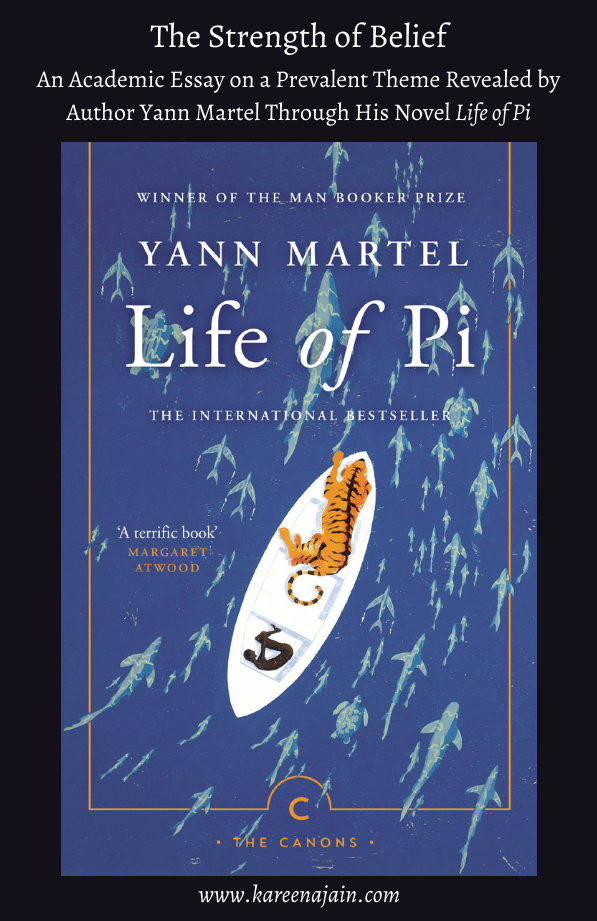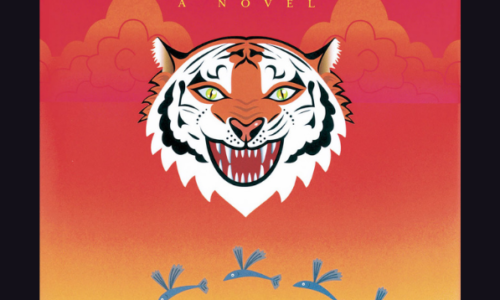Hello everybody! Today’s post is going to be a slight deviation from my regular posting. Instead of a book review, I’m going to be sharing an academic essay I recently wrote that earned me some encouraging words from my English teacher of two years, who wrote, “I feel like I have maybe pushed you a little bit this year, and with this essay you have really reached that level I can usually only wish to see. The depth of your thought in this essay is excellent. I am really proud of you.”
Her message spurred me to share this essay which examines a prevalent theme in the well-known novel Life of Pi by Yann Martel and provides insight into the beautiful message of belief and human nature shared by the author.
~ ~ ~
Belief is a uniquely human quality. It is the complete trust in the assumption of something greater that cannot be seen. The world is a difficult place to understand, so any belief, whether it be a deity of religious lore or a proven theory with scientific standing, provides a palatable explanation for why life is the way it is. The power of such conviction is cleverly exposed by author Yann Martel through his novel Life of Pi, in which he utilizes the characterization of Piscine ‘Pi’ Molitor Patel and the bleak setting of the Pacific Ocean to reveal the importance of faith because the strength of belief is what gives people the will to survive. They are able to withstand because their belief provides them with a reward, an incentive for their endurance. As well, having faith is a testament to the will of a person, because it is difficult to maintain. When the reality of life is too cruel to even fathom, faith in something more will give a believer one more motive to carry on. Finally, faith is possessed by people around the globe. Everyone believes in something, and this shared belief of a bright yet unknown future is what connects humans worldwide, and makes them firm in their resolutions.
As Pi is growing up in Pondicherry, India, he finds himself invested in Hinduism, Christianity, and Islam, as well as in the natural sciences, having grown up in a zoo owned by his father. Pi’s multi-faceted faith lends him the understanding that individual differences are not so important; dissimilar faiths are all similar in their habit of using their belief to explain this mysterious world. He understands that faith is a driving force, no matter the object of worship. Even if the other person is an atheist, they believe in the absence of a god. Their actions are motivated by scientific curiosity instead. When complaining about agnostics, Pi states “To choose doubt as a philosophy of life is akin to choosing immobility as a means of transportation” (Martel 31). If a person does not hope for divine reward or satisfied inquiry, what propulsion exists in their life to keep them moving forward? This harkens back to basic human nature: if one sets a reward for a task, then finishing this task will result in immediate gratification, a rush of dopamine flooding the nervous system. Having faith is nothing more than a divine reward system, the fruits of which are infinitely sweeter. Pi had felt this bliss twice in his life, before and after his shipwreck, and he tells the reader “The presence of God is the finest of rewards” (69). The blessings differ from person to person, but they are the reason people pave their path despite the difficulties. Their faith in something bigger helps people easily acclimate to the tumultuous terrains of life and allows them to live for something greater than themselves.
After the Tsimtsum sinks and all the other animals are dead, Pi struggles not only to survive, but to reconcile the changes he has undergone with the devout boy he once was. In the human story told to the Japanese officials, it is revealed that the tiger, Richard Parker, is merely a manifestation of Pi’s surfaced animal instincts, likely created by his traumatized mind. Both the animal and human scenarios are harsh, and any person’s morale would severely flag. Pi’s did as well, his belief threatening to leave him. His faith in God is later renewed as he understands that Richard Parker essentially depends on Pi to survive. During a fierce thunderstorm at sea, Pi says to the tiger “If I didn’t have you now, I don’t know what I would do. I don’t think I would make it. No, I wouldn’t. I would die of hopelessness. Don’t give up, Richard Parker, don’t give up. I’ll get you to land, I promise, I promise!” (262). Pi pushes away his pain to focus on survival, because he believes that he can train his tiger and keep them both alive. The once-peaceful vegetarian guts fish, tames a tiger, and survives by himself for 227 days. His renewed faith is in himself, a notion that readers should recognize and internalize: when the future seems distant and belief in God is difficult, believing in oneself is just as potent a drug, capable of pushing people to be their best. Later, when Pi stumbles upon the carnivorous island, it is a welcome reprieve that is swiftly snatched away upon his discovery that the vegetation is not friendly. When leaving the island, Pi tells the readers that “High calls low and low calls high. I tell you, if you were in such dire straits as I was, you too would elevate your thoughts. The lower you are, the higher your mind will want to soar. It was natural that, bereft and desperate as I was, in the throes of unremitting suffering, I should turn to God” (314). He has lost any and all hope of survival, so he turns to the omnipotent. He keeps himself and the tiger alive, never losing faith, and the next stop they run aground at is the safe coast of Mexico. Belief, in both Pi’s situation and in real life, is a candle that can light even the darkest of times. It is a lantern meant to guide those who feel cursed down the foggy road of despair towards the victorious glow of survival.
When Pi is safe in a Mexican hospital, he tells his story to the Japanese officials. When they hear Pi’s tale with the animals, they demand the truth and not another story. Pi replies to them, saying “The world isn’t just the way it is. It is how we understand it, no? And in understanding something, we bring something to it, no? Doesn’t that make life a story?” (335). In some ways, life is similar to religion. Both are composed of stories that help people understand the world a little better. Every person’s life is a little different, and these accounts connect in intricate patterns, carefully revealing the power of belief in its ability to bridge lives around the globe. When people swap experiences, they find the courage to press on themselves. After Pi gives the Japanese officials his two stories, he asks them which one they preferred. The following transcript reads, “Mr. Chiba: ‘The story with animals.’ Mr. Okamoto: ‘Yes. The story with animals is the better story.’ Pi Patel: ‘Thank you. And so it goes with God’” (352). The Japanese officials and Pi prefer the story with the animals because it masks the true brutality of humans and seems to boast the presence of divinity. This is just another kind of belief that can be found within the novel: faith in a story that is so fantastical and unbelievable that it is tirelessly inspiring. The tale of a boy and tiger is how Pi’s mind chooses to comprehend his trauma, but to readers, it is a much more inspiring tale than of a boy all alone, because the struggle is tangible. No matter what faith one may hold, all readers will choose the more miraculous of the two stories, because through fantasy, they find the ability to confront their own demons.
The world runs on belief. Belief leads to hope, which feeds fortitude, which will in turn push a person to live. This is a central theme developed in the novel Life of Pi by author Yann Martel. Pi’s childhood journey and initial character development are used to introduce the concept that belief in something greater gives people a better understanding of the world. During Pi’s harrowing time at sea, the cheerless backdrop to the majority of the novel, Martel writes about how faith gives people inspiration in difficult times, encouraging bravery in the face of adversity. Through the conversation between Pi and the Japanese officials, the author accurately represents the general populace through the officials, reminding readers that faith is a constant choice, an inspiration, and a subtle magic that has woven a net of similarity and cast it on all the people living on this planet. Such stalwart belief is crucial at this point in human history, with the COVID-19 pandemic taking a toll on friends, family, and mental and physical health indiscriminately. Lockdowns due to the virus have not been easy, but faith has been triumphant. So long as this world’s society continues to hold fast to their belief in their religions, their families, and themselves, they will be willing and able to stay safe and survive. This strength to endure is a very human trait, and it is belief that actually gives humans the resolve to persevere.
Works Cited
Martel, Yann. Life of Pi. Vintage Canada, 2002.



